Instrument INFINITI QX50 2019 Owner's Manual
[x] Cancel search | Manufacturer: INFINITI, Model Year: 2019, Model line: QX50, Model: INFINITI QX50 2019Pages: 573, PDF Size: 7.4 MB
Page 2 of 573
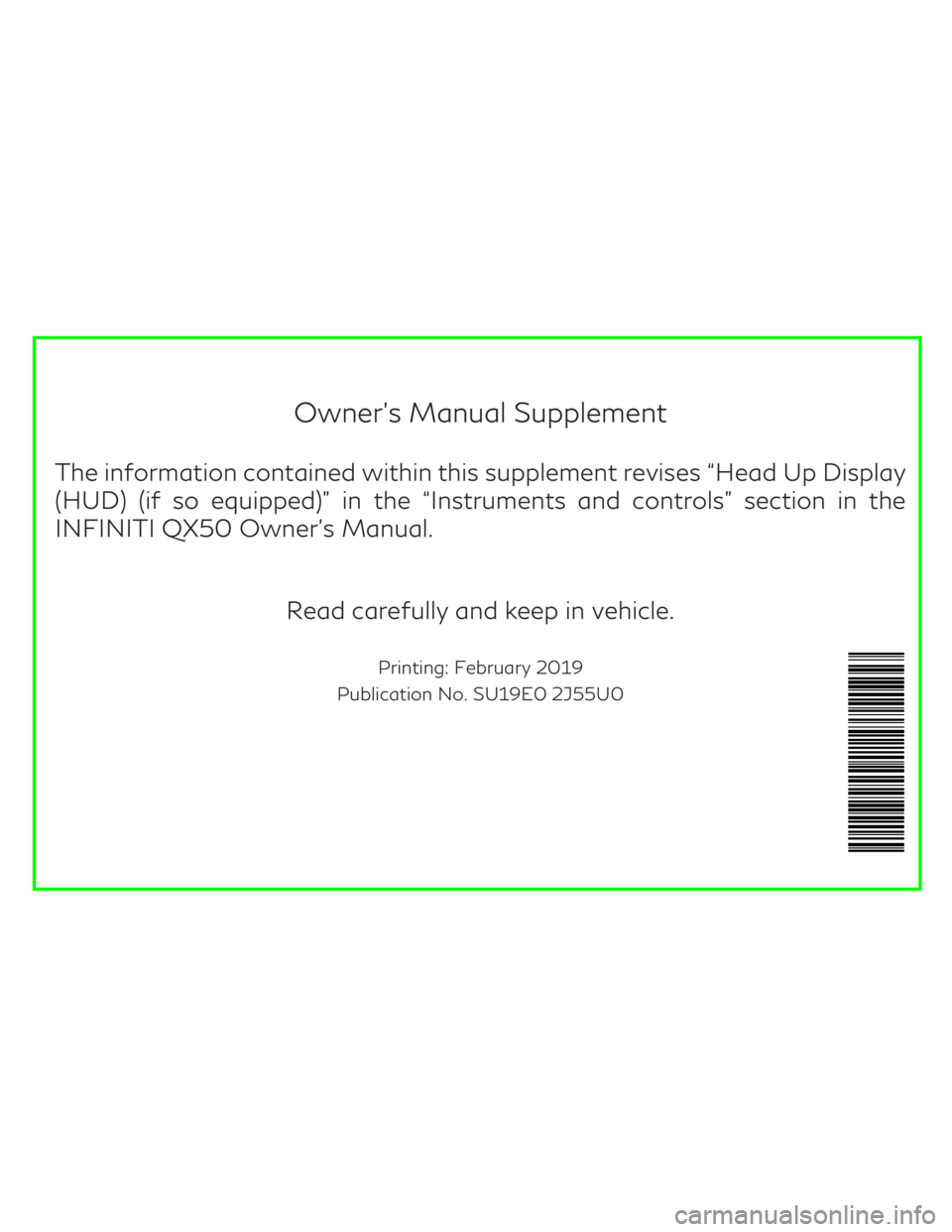
Owner’s Manual Supplement
The information contained within this supplement revises “Head Up Display
(HUD) (if so equipped)” in the “Instruments and controls” section in the
INFINITI QX50 Owner’s Manual.
Read carefully and keep in vehicle.
Printing: February 2019
Publication No. SU19E0 2J55U0
Page 6 of 573
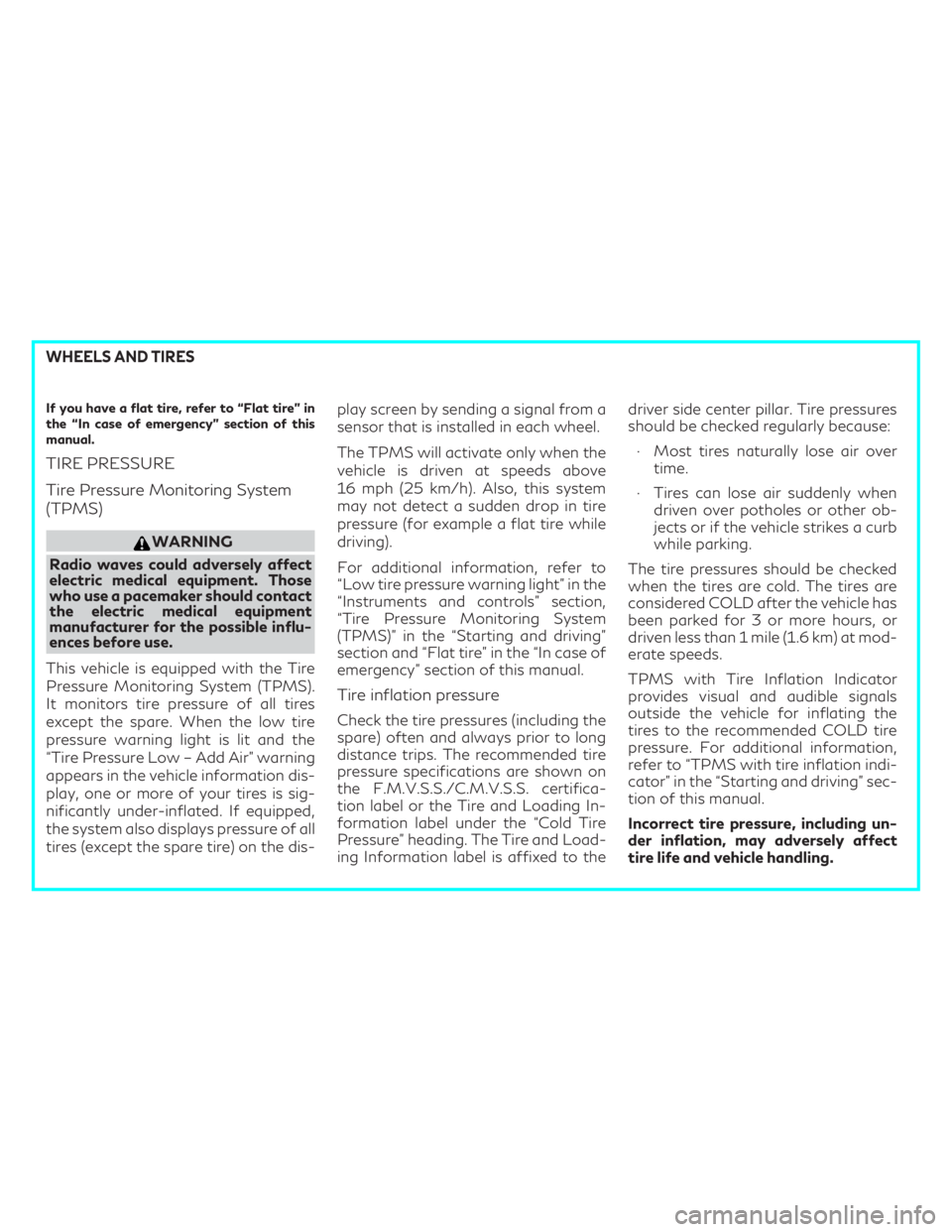
If you have a flat tire, refer to “Flat tire” in
the “In case of emergency” section of this
manual.
TIRE PRESSURE
Tire Pressure Monitoring System
(TPMS)
WARNING
Radio waves could adversely affect
electric medical equipment. Those
who use a pacemaker should contact
the electric medical equipment
manufacturer for the possible influ-
ences before use.
This vehicle is equipped with the Tire
Pressure Monitoring System (TPMS).
It monitors tire pressure of all tires
except the spare. When the low tire
pressure warning light is lit and the
“Tire Pressure Low – Add Air” warning
appears in the vehicle information dis-
play, one or more of your tires is sig-
nificantly under-inflated. If equipped,
the system also displays pressure of all
tires (except the spare tire) on the dis- play screen by sending a signal from a
sensor that is installed in each wheel.
The TPMS will activate only when the
vehicle is driven at speeds above
16 mph (25 km/h). Also, this system
may not detect a sudden drop in tire
pressure (for example a flat tire while
driving).
For additional information, refer to
“Low tire pressure warning light” in the
“Instruments and controls” section,
“Tire Pressure Monitoring System
(TPMS)” in the “Starting and driving”
section and “Flat tire” in the “In case of
emergency” section of this manual.
Tire inflation pressure
Check the tire pressures (including the
spare) often and always prior to long
distance trips. The recommended tire
pressure specifications are shown on
the F.M.V.S.S./C.M.V.S.S. certifica-
tion label or the Tire and Loading In-
formation label under the “Cold Tire
Pressure” heading. The Tire and Load-
ing Information label is affixed to thedriver side center pillar. Tire pressures
should be checked regularly because:
∙ Most tires naturally lose air over time.
∙ Tires can lose air suddenly when driven over potholes or other ob-
jects or if the vehicle strikes a curb
while parking.
The tire pressures should be checked
when the tires are cold. The tires are
considered COLD after the vehicle has
been parked for 3 or more hours, or
driven less than 1 mile (1.6 km) at mod-
erate speeds.
TPMS with Tire Inflation Indicator
provides visual and audible signals
outside the vehicle for inflating the
tires to the recommended COLD tire
pressure. For additional information,
refer to “TPMS with tire inflation indi-
cator” in the “Starting and driving” sec-
tion of this manual.
Incorrect tire pressure, including un-
der inflation, may adversely affect
tire life and vehicle handling.
WHEELS AND TIRES
Page 16 of 573

Table of
ContentsIllustrated table of contents
Safety—Seats, seat belts and supplemental restraint system
Instruments and controls
Pre-driving checks and adjustments
Monitor, climate, audio, phone and voice recognition systems
Starting and driving
In case of emergency
Appearance and care
Do-it-yourself
Maintenance and schedules
Technical and consumer information
Index
0
1
2
3
4
5
6
7
8
9
10
11
Page 18 of 573

0 Illustrated table of contents
Air bags, seat belts and child restraints........... 0-2
Exterior front ................................... 0-3
Exterior rear .................................... 0-4
Passenger compartment ......................... 0-5 Instrument panel
................................ 0-6
Engine compartment check locations ............. 0-8
Warning and indicator lights ..................... 0-9
Page 23 of 573
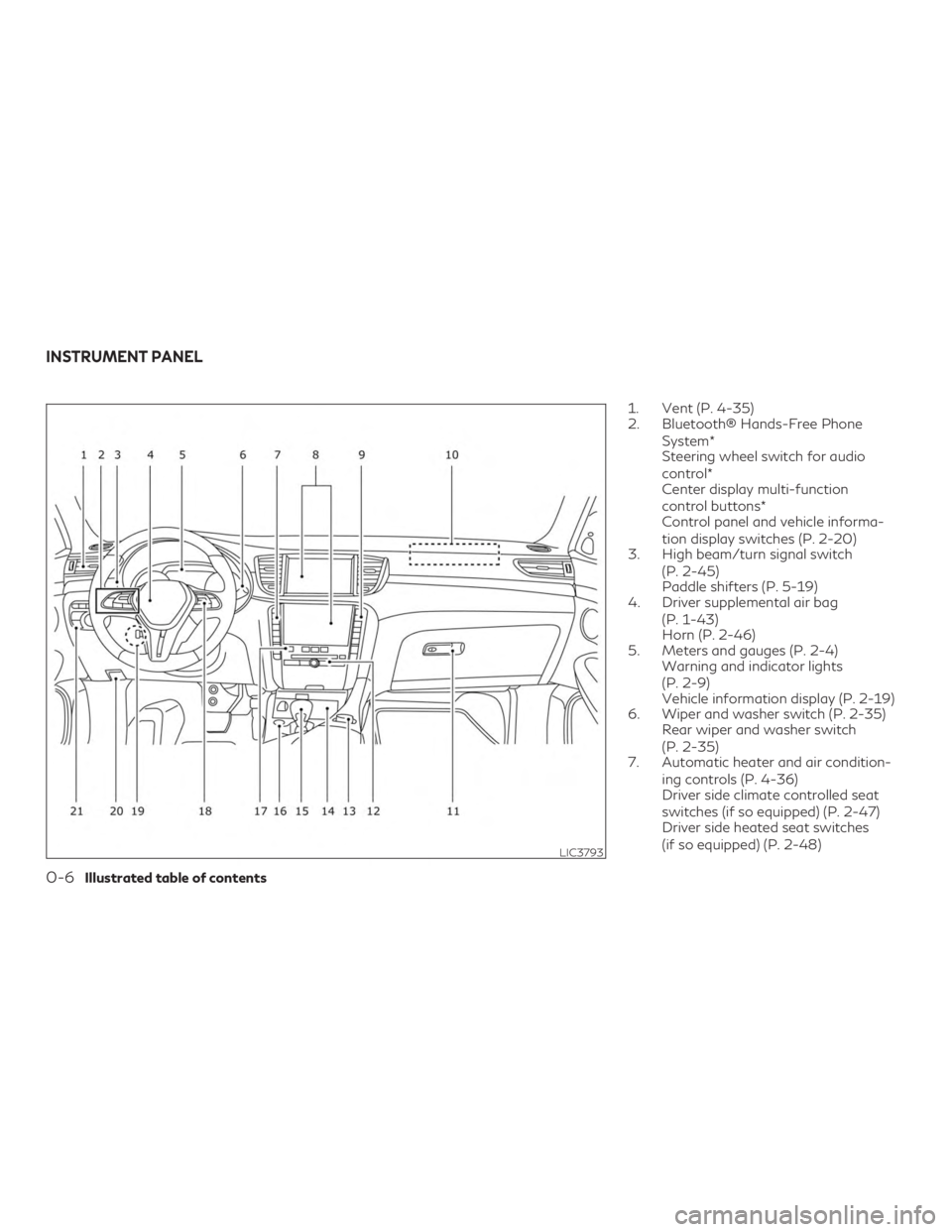
1. Vent (P. 4-35)
2. Bluetooth® Hands-Free PhoneSystem*
Steering wheel switch for audio
control*
Center display multi-function
control buttons*
Control panel and vehicle informa-
tion display switches (P. 2-20)
3. High beam/turn signal switch
(P. 2-45)
Paddle shifters (P. 5-19)
4. Driver supplemental air bag
(P. 1-43)
Horn (P. 2-46)
5. Meters and gauges (P. 2-4) Warning and indicator lights
(P. 2-9)
Vehicle information display (P. 2-19)
6. Wiper and washer switch (P. 2-35) Rear wiper and washer switch
(P. 2-35)
7. Automatic heater and air condition-
ing controls (P. 4-36)
Driver side climate controlled seat
switches (if so equipped) (P. 2-47)
Driver side heated seat switches
(if so equipped) (P. 2-48)
LIC3793
INSTRUMENT PANEL
0-6Illustrated table of contents
Page 24 of 573

8. Upper and lower displays*Navigation system* (if so equipped)
9. Automatic heater and air condition-
ing controls (P. 4-36)
Passenger side climate controlled
seat switches (if so equipped)
(P. 2-47)
Passenger side heated seat
switches (if so equipped) (P. 2-48)
Rear window defroster, outside
mirror defroster, and wiper deicer
(if so equipped) switch (P. 2-39)
10. Front passenger supplemental air
bag (P. 1-43)
11. Glove box (P. 2-55)
12. Audio system controls* Front passenger air bag status light
(P. 1-43)
13. INFINITI controller*
14. Power outlet (P. 2-53) USB charging port (P. 4-44)
Cup holders (P. 2-55)
Storage (P. 2-55)
15. Shift lever (P. 5-19)
16. Push-button ignition switch
(P. 5-13)
Electronic parking brake switch
(P. 5-24) 17. Hazard warning flasher switch
(P. 6-2)
18. ProPILOT Assist Switch
(if so equipped) (P. 5-108)
Cruise control switches
(if so equipped) (P. 5-82)
Intelligent Cruise Control (ICC)
switches (if so equipped) (P. 5-84)
Distance control switch
(if so equipped) (P. 5-84)
Control panel and vehicle informa-
tion display switches (P. 2-20)
19. Tilt and telescopic steering wheel
control (P. 3-34)
20. Hood release (P. 3-24)
21. Trip reset switch (P. 2-4) Instrument brightness control
(P. 2-39)
Front and rear sonar system
(if so equipped) (P. 5-186)
Steering assist switch (for vehicles
with ProPILOT Assist) (if so
equipped) (P. 2-50)
Dynamic driver assistance switch
(for vehicles without ProPILOT
Assist) (if so equipped) (P. 2-49)
Liftgate release switch (P. 3-24)
Headlight switch (P. 2-39) Fog light switch (if so equipped)
(P. 2-46)
Head Up Display (HUD) OFF switch
(if so equipped) (P. 2-51)
*: Refer to the separate INFINITI InTouchTM
Owner’s Manual.
Refer to the page number indicated in paren-
theses for operating details.
Illustrated table of contents0-7
Page 41 of 573
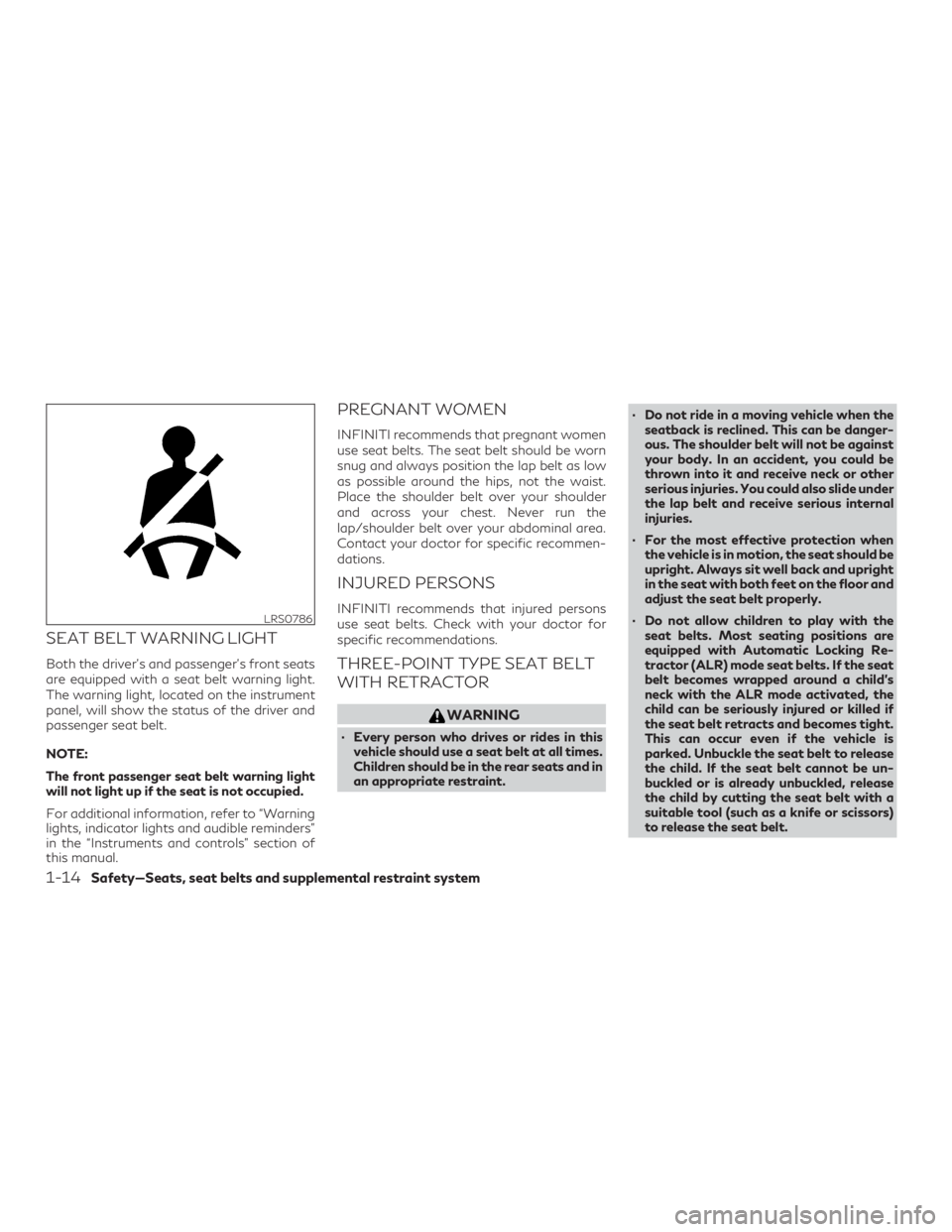
SEAT BELT WARNING LIGHT
Both the driver’s and passenger’s front seats
are equipped with a seat belt warning light.
The warning light, located on the instrument
panel, will show the status of the driver and
passenger seat belt.
NOTE:
The front passenger seat belt warning light
will not light up if the seat is not occupied.
For additional information, refer to “Warning
lights, indicator lights and audible reminders”
in the “Instruments and controls” section of
this manual.
PREGNANT WOMEN
INFINITI recommends that pregnant women
use seat belts. The seat belt should be worn
snug and always position the lap belt as low
as possible around the hips, not the waist.
Place the shoulder belt over your shoulder
and across your chest. Never run the
lap/shoulder belt over your abdominal area.
Contact your doctor for specific recommen-
dations.
INJURED PERSONS
INFINITI recommends that injured persons
use seat belts. Check with your doctor for
specific recommendations.
THREE-POINT TYPE SEAT BELT
WITH RETRACTOR
WARNING
∙ Every person who drives or rides in thisvehicle should use a seat belt at all times.
Children should be in the rear seats and in
an appropriate restraint. ∙ Do not ride in a moving vehicle when the
seatback is reclined. This can be danger-
ous. The shoulder belt will not be against
your body. In an accident, you could be
thrown into it and receive neck or other
serious injuries. You could also slide under
the lap belt and receive serious internal
injuries.
∙ For the most effective protection when the vehicle is in motion, the seat should be
upright. Always sit well back and upright
in the seat with both feet on the floor and
adjust the seat belt properly.
∙ Do not allow children to play with the seat belts. Most seating positions are
equipped with Automatic Locking Re-
tractor (ALR) mode seat belts. If the seat
belt becomes wrapped around a child’s
neck with the ALR mode activated, the
child can be seriously injured or killed if
the seat belt retracts and becomes tight.
This can occur even if the vehicle is
parked. Unbuckle the seat belt to release
the child. If the seat belt cannot be un-
buckled or is already unbuckled, release
the child by cutting the seat belt with a
suitable tool (such as a knife or scissors)
to release the seat belt.
LRS0786
1-14Safety—Seats, seat belts and supplemental restraint system
Page 70 of 573
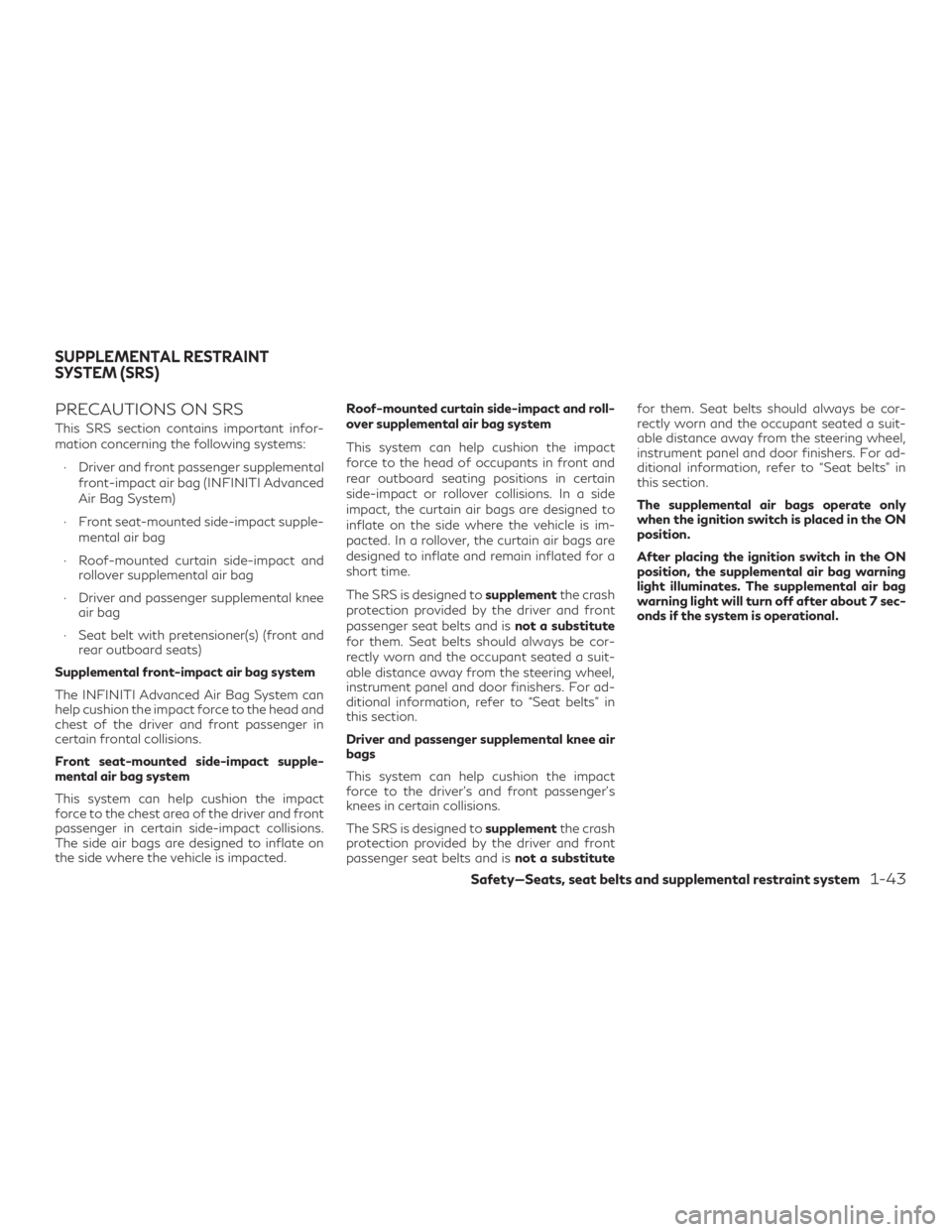
PRECAUTIONS ON SRS
This SRS section contains important infor-
mation concerning the following systems:∙ Driver and front passenger supplemental front-impact air bag (INFINITI Advanced
Air Bag System)
∙ Front seat-mounted side-impact supple- mental air bag
∙ Roof-mounted curtain side-impact and rollover supplemental air bag
∙ Driver and passenger supplemental knee air bag
∙ Seat belt with pretensioner(s) (front and rear outboard seats)
Supplemental front-impact air bag system
The INFINITI Advanced Air Bag System can
help cushion the impact force to the head and
chest of the driver and front passenger in
certain frontal collisions.
Front seat-mounted side-impact supple-
mental air bag system
This system can help cushion the impact
force to the chest area of the driver and front
passenger in certain side-impact collisions.
The side air bags are designed to inflate on
the side where the vehicle is impacted. Roof-mounted curtain side-impact and roll-
over supplemental air bag system
This system can help cushion the impact
force to the head of occupants in front and
rear outboard seating positions in certain
side-impact or rollover collisions. In a side
impact, the curtain air bags are designed to
inflate on the side where the vehicle is im-
pacted. In a rollover, the curtain air bags are
designed to inflate and remain inflated for a
short time.
The SRS is designed to
supplementthe crash
protection provided by the driver and front
passenger seat belts and is not a substitute
for them. Seat belts should always be cor-
rectly worn and the occupant seated a suit-
able distance away from the steering wheel,
instrument panel and door finishers. For ad-
ditional information, refer to “Seat belts” in
this section.
Driver and passenger supplemental knee air
bags
This system can help cushion the impact
force to the driver’s and front passenger’s
knees in certain collisions.
The SRS is designed to supplementthe crash
protection provided by the driver and front
passenger seat belts and is not a substitutefor them. Seat belts should always be cor-
rectly worn and the occupant seated a suit-
able distance away from the steering wheel,
instrument panel and door finishers. For ad-
ditional information, refer to “Seat belts” in
this section.
The supplemental air bags operate only
when the ignition switch is placed in the ON
position.
After placing the ignition switch in the ON
position, the supplemental air bag warning
light illuminates. The supplemental air bag
warning light will turn off after about 7 sec-
onds if the system is operational.
SUPPLEMENTAL RESTRAINT
SYSTEM (SRS)
Safety—Seats, seat belts and supplemental restraint system1-43
Page 71 of 573

WARNING
∙ The front air bags ordinarily will not in-flate in the event of a side impact, rear
impact, rollover, or lower severity frontal
collision. Always wear your seat belts to
help reduce the risk or severity of injury in
various kinds of accidents.
∙ The front passenger air bag will not in- flate if the passenger air bag status light
is lit. For additional information, refer to
“Front passenger air bag and status
light” in this section. ∙ The seat belts and the front air bags are
most effective when you are sitting well
back and upright in the seat. The front air
bags inflate with great force. Even with
the INFINITI Advanced Air Bag System, if
you are unrestrained, leaning forward,
sitting sideways or out of position in any
way, you are at greater risk of injury or
death in a crash. You may also receive
serious or fatal injuries from the front air
bag if you are up against it when it in-
flates. Always sit back against the seat-
back and as far away as practical from
the steering wheel or instrument panel.
Always properly use the seat belts. ∙ The driver and front passenger seat belt
buckles are equipped with sensors that
detect if the seat belts are fastened. The
INFINITI Advanced Air Bag System
monitors the severity of a collision and
seat belt usage then inflates the air bags
as needed. Failure to properly wear seat
belts can increase the risk or severity of
injury in an accident.
∙ The front passenger seat is equipped with an occupant classification sensor
(weight sensor) that turns the front pas-
senger air bag OFF under some condi-
tions. This sensor is only used in this seat.
Failure to be properly seated and wear-
ing the seat belt can increase the risk or
severity of injury in an accident. For addi-
tional information, refer to “Front pas-
senger air bag and status light” in this
section.
∙ Keep hands on the outside of the steering wheel. Placing them inside the steering
wheel rim could increase the risk that
they are injured when the front air bag
inflates.
WRS0031
1-44Safety—Seats, seat belts and supplemental restraint system
Page 78 of 573
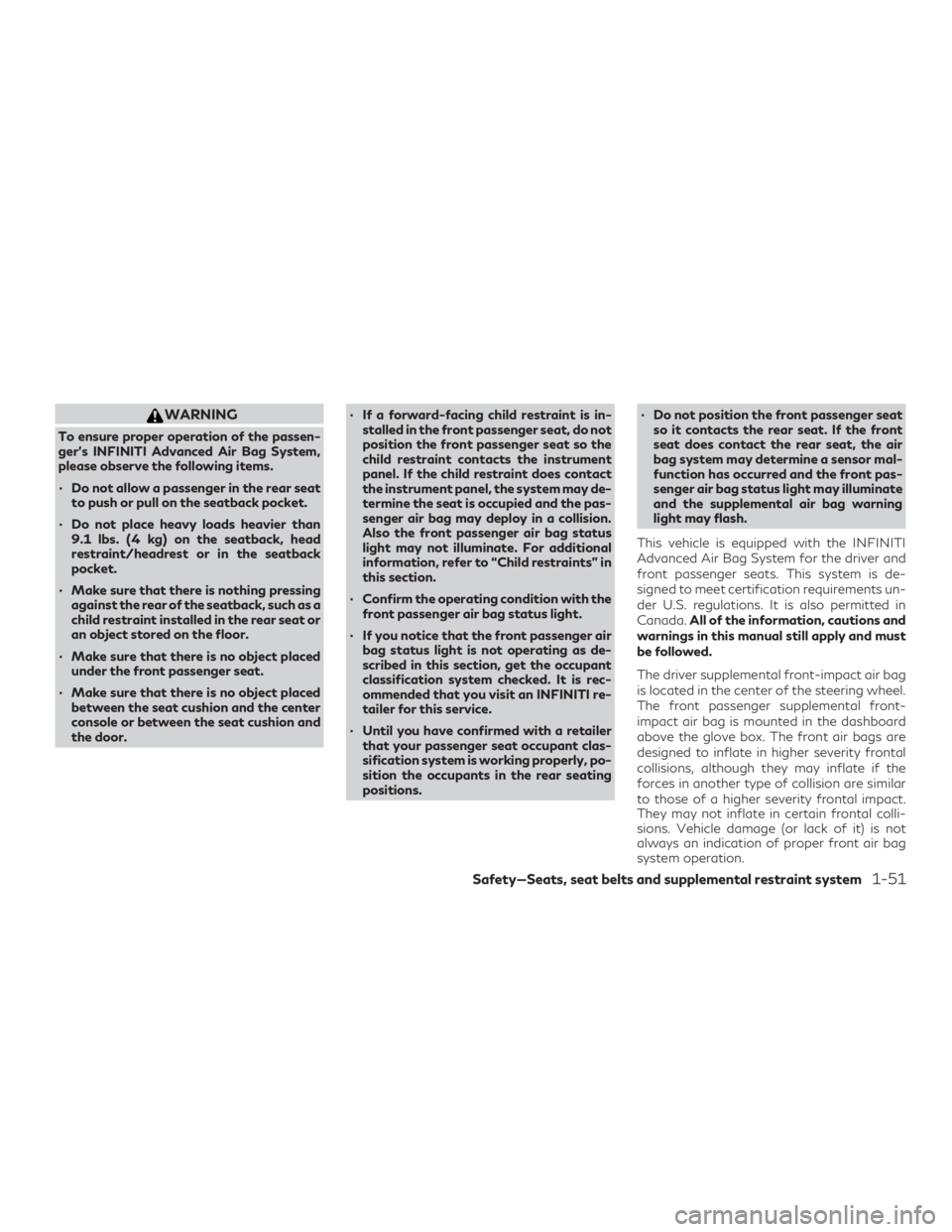
WARNING
To ensure proper operation of the passen-
ger’s INFINITI Advanced Air Bag System,
please observe the following items.
∙ Do not allow a passenger in the rear seatto push or pull on the seatback pocket.
∙ Do not place heavy loads heavier than 9.1 lbs. (4 kg) on the seatback, head
restraint/headrest or in the seatback
pocket.
∙ Make sure that there is nothing pressing against the rear of the seatback, such as a
child restraint installed in the rear seat or
an object stored on the floor.
∙ Make sure that there is no object placed under the front passenger seat.
∙ Make sure that there is no object placed between the seat cushion and the center
console or between the seat cushion and
the door. ∙ If a forward-facing child restraint is in-
stalled in the front passenger seat, do not
position the front passenger seat so the
child restraint contacts the instrument
panel. If the child restraint does contact
the instrument panel, the system may de-
termine the seat is occupied and the pas-
senger air bag may deploy in a collision.
Also the front passenger air bag status
light may not illuminate. For additional
information, refer to “Child restraints” in
this section.
∙ Confirm the operating condition with the front passenger air bag status light.
∙ If you notice that the front passenger air bag status light is not operating as de-
scribed in this section, get the occupant
classification system checked. It is rec-
ommended that you visit an INFINITI re-
tailer for this service.
∙ Until you have confirmed with a retailer that your passenger seat occupant clas-
sification system is working properly, po-
sition the occupants in the rear seating
positions. ∙ Do not position the front passenger seat
so it contacts the rear seat. If the front
seat does contact the rear seat, the air
bag system may determine a sensor mal-
function has occurred and the front pas-
senger air bag status light may illuminate
and the supplemental air bag warning
light may flash.
This vehicle is equipped with the INFINITI
Advanced Air Bag System for the driver and
front passenger seats. This system is de-
signed to meet certification requirements un-
der U.S. regulations. It is also permitted in
Canada. All of the information, cautions and
warnings in this manual still apply and must
be followed.
The driver supplemental front-impact air bag
is located in the center of the steering wheel.
The front passenger supplemental front-
impact air bag is mounted in the dashboard
above the glove box. The front air bags are
designed to inflate in higher severity frontal
collisions, although they may inflate if the
forces in another type of collision are similar
to those of a higher severity frontal impact.
They may not inflate in certain frontal colli-
sions. Vehicle damage (or lack of it) is not
always an indication of proper front air bag
system operation.
Safety—Seats, seat belts and supplemental restraint system1-51